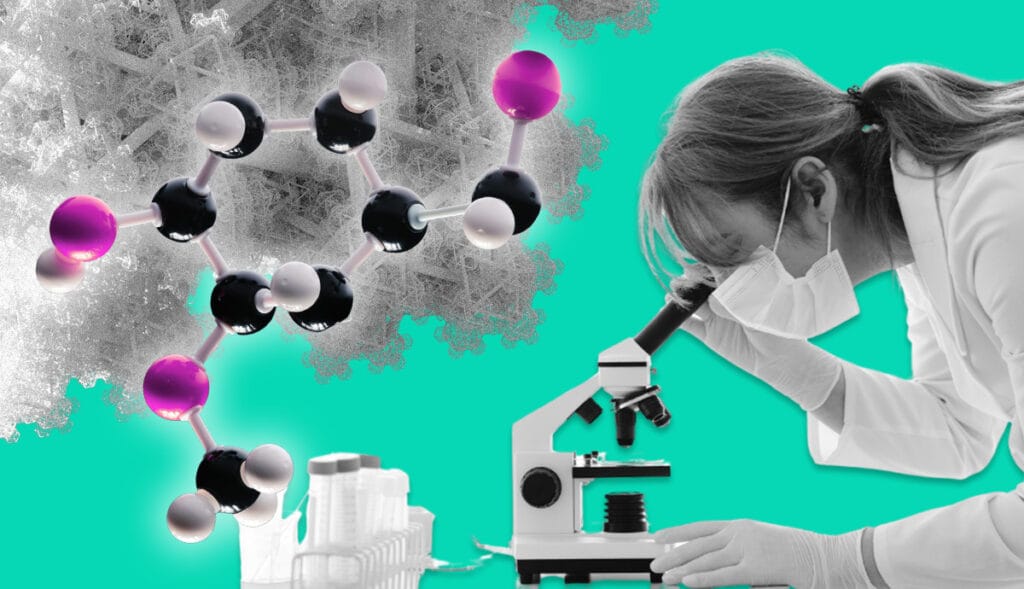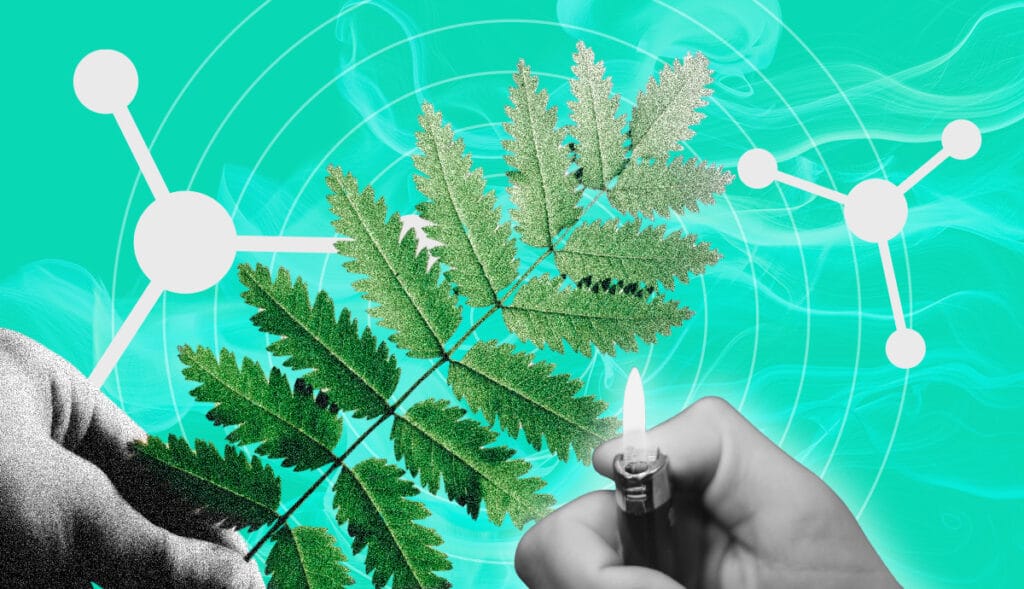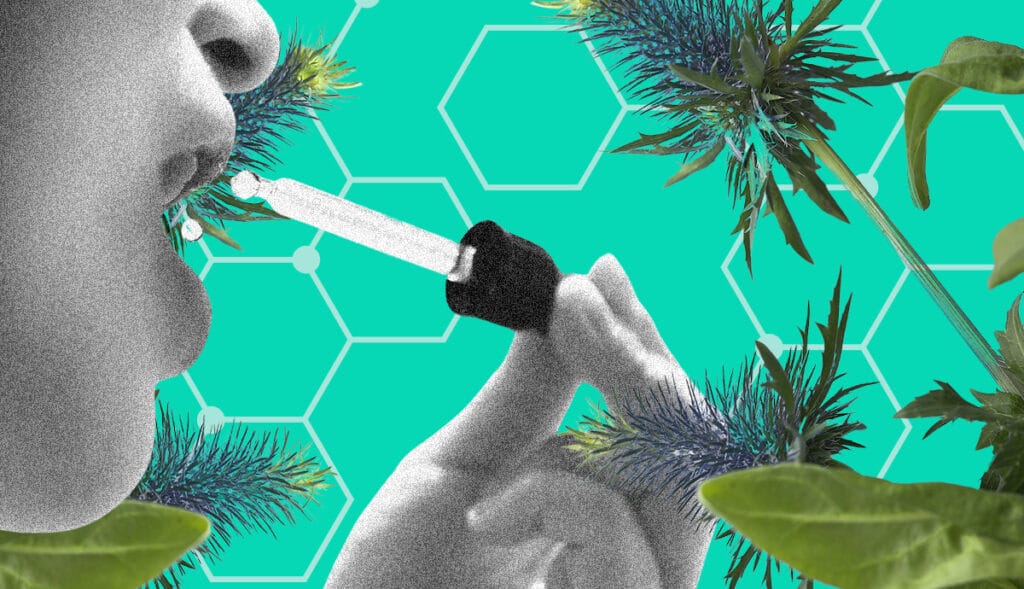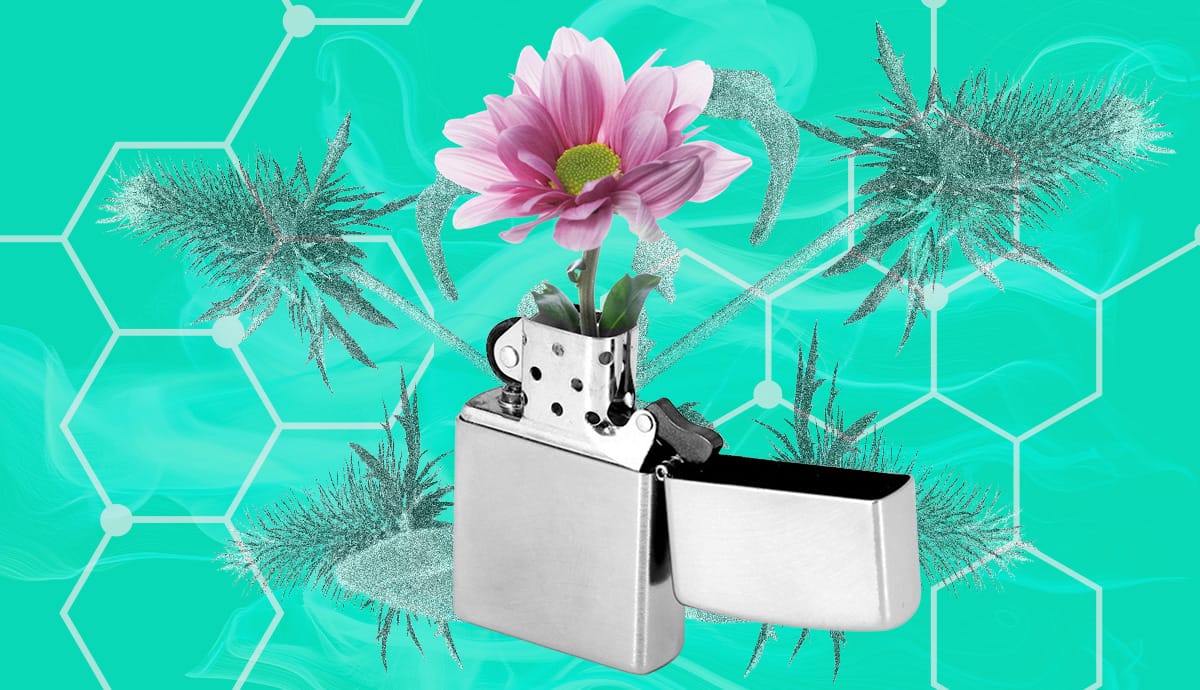Cannabis is not typically regarded as a psychedelic, but scientific evidence tells us it should be.
Abundant anecdotal evidence of cannabis’ therapeutic applications, explored in Part One of this series, makes it hard to deny its potential as a powerful plant medicine, used similarly to psilocybin and MDMA in clinical and ceremonial settings.
But new science around the flavorant indole found in cannabis (and many other entheogens) may have significant implications for reclassifying the plant as, indeed, psychedelic.
It’s not just indole; there’s more psychedelic chemistry at play within cannabis regarding what defines a psychedelic substance. Is indole a missing key to classify cannabis as a psychedelic? Which drug class does cannabis belong to now? Do people hallucinate from cannabis, and are hallucinogens the same as psychedelics? What defines a psychedelic, and how would cannabis scientifically fit into that category?

Factors Influencing Cannabis’s Psychedelic Potential
Cannabis is not traditionally regarded as a psychedelic, although it can be a potent psychedelic when certain variables align. Factors like the individual’s set and setting, tolerance, and cannabis type can determine whether the experience is typical, or, indeed, psychedelic.
There are books, online courses, ceremonial practices, and legitimate research all dedicated to the psychedelic cannabis experience. I’ve had many psychedelic experiences with cannabis that range from subtle effects, to experiences comparable with DMT trips. I’ve also witnessed people experiencing cannabis as if it were ayahuasca. However, these psychedelic-like effects arising from cannabis use are rare, because cannabis in all its varieties (and the people who consume it) are wildly diverse.
However, extreme psychedelic experiences are not necessary to deem cannabis psychedelic. In fact, cannabis has more multifaceted psychedelic chemistry than one might think. Before diving into the chemistry, let’s evaluate how cannabis is classified right now.
The Current Classification of Cannabis
Cannabis is one of the most complex, widely consumed drugs due to its differentiated psychoactive chemistry, and classifying it is complicated. Although a drug class typically defines the type of drug it is, both NIDA and the WHO recently removed their authoritative online resources regarding the drug class cannabis falls within. Others, such as The Discovery Institute and IACP classify cannabis in its own drug class, which makes sense given its diversity.
All at once, cannabis bears depressant and sedative properties, along with stimulating attributes, and psychedelic or hallucinatory potential. Depending on the strain (of which there are thousands) and the tolerance and the unique biochemistry of the individual consuming it, the effects of the plant can vary wildly.
Cannabis is currently undergoing federal rescheduling, and deserves its own official drug class, too.
Understanding Psychedelics vs. Hallucinogens. Where Does Cannabis Fit?
To determine if cannabis is a psychedelic, it is essential to understand what a psychedelic is and how it may differ from a purely hallucinogenic experience.
Psychedelics are a class of psychoactive substances that primarily influence the brain by altering perception, mood, and cognitive processes. While they are known for inducing hallucinations, not all hallucinogens are classified as psychedelics. The specific characteristics that define a psychedelic drug include:
- Mechanism of Action: Psychedelics primarily exert their effects by acting on serotonin receptors, especially the 5-HT2A receptor. This interaction is crucial for the psychedelic experience. Classic psychedelics such as LSD, psilocybin, and DMT fall into this category.
- Subjective Effects or Altered Perceptions: Psychedelics can profoundly alter sensory perception, leading to vivid visual and auditory hallucinations, synesthesia (blending of senses), and intensified colors and patterns.
- Cognitive and Emotional Effects: Users often report altered thought processes, enhanced introspection, and a sense of connectedness. There can be profound emotional changes, ranging from euphoria to introspective insight.
- Mystical Experiences: Many users describe experiences of unity, transcendence, and a sense of encountering a greater reality or consciousness.
- Non-Toxic and Low Addiction Potential: Classic psychedelics are generally non-toxic and do not lead to physical dependence or addiction. While they can cause psychological distress or trigger latent mental health issues in susceptible individuals, their physical safety margin is considered high compared to many other psychoactive substances.
- Distinct Pharmacological and Neurobiological Effects: Ego dissolution, where the user’s sense of self is temporarily diminished or dissolved, is a defining characteristic of psychedelics. This is less common with other hallucinogens.
Other natural plant-based hallucinogens that are not psychedelic include dissociatives and deliriants. Substances like Salvia Divinorum, Datura, Brugmansia, and Mandrake produce hallucinations, but primarily, cause a sense of detachment from reality and one’s body rather than the profound sensory and emotional alterations typical of psychedelics. Experiences from these plants are often characterized by confusion, a lack of insight, and a greater risk of dangerous behaviors. They can also be so toxic that they can become lethal, unlike plant-based psychedelics, which are generally non-toxic.
Is Cannabis a Psychedelic or a Hallucinogen?
Simply, cannabis can be both (though it is typically neither). I’ve experienced both minor and major hallucinations from cannabis that were not inherently psychedelic, including hearing and feeling my phone ringing when it’s silent, seeing plants come alive, and movement from inanimate objects. Sounds and colors may be enhanced, and some visual distortions may occur, all of which are forms of hallucinations, but not necessarily psychedelic experiences.
As a researcher, educator, expert witness, and daily cannabis consumer for over 25 years, I’ve concluded that cannabis is also a psychedelic, not just a hallucinogen.

Factors Influencing the Psychedelic Experience of Cannabis
Achieving a true psychedelic state with cannabis depends on both experiential and scientific factors. Key elements include tolerance, the user’s intention, the specific strain of cannabis, its chemical composition, and how we categorize what makes a substance psychedelic. Each of these factors works together to shape the depth and nature of the experience, highlighting the complex interplay between personal mindset, biological response, and the characteristics of the cannabis used.
Tolerance: Cannabis tends to be more intense and psychedelic when you have a low tolerance to it. Many people report experiencing stronger, more hallucinatory effects when they first used cannabis. Taking a tolerance break can help recreate these experiences.
Intention: Structured intention plays a key role in enhancing cannabis’ psychedelic effects. Even with high tolerance, combining cannabis with meditation and ceremony can lead to intense experiences similar to other psychedelics. Mindfulness and a proper set and setting are crucial.
Strain: Choosing the right strain is important. Sativa or “narrow-leaf type” varieties with citrus and gas-like aromas are typically more psychedelic. Using tools like Interpening can help identify cannabis strains that will deliver the desired effects. The aroma type of narrow-leaf cannabis is typically hallmarked by citrus terpenes and ‘sulfuric thiols’ which smell like gas; Tropicanna Sulfur Compounds “TCSCs” (citrus-funk), and heterocyclics like indole with sharp chemical smells.
Introducing Indole: The Missing Psychedelic Cannabis Link
Indole is the core structural group of psychedelic tryptamines such as DMT, LSD, and psilocybin-bearing mushrooms, and surprise: it’s commonly found in cannabis, too.
Since indole is found in many cannabis strains, some might speculate whether it contributes to cannabis being psychedelic. Indole itself doesn’t cause psychedelic effects. It’s a foundational structure that forms part of many important compounds. It serves as a core structure for many biologically active compounds, including neurotransmitters like serotonin and several psychedelics.
However, indole serves as a scaffold that, when modified with specific functional groups, can interact with brain receptors to produce psychedelic effects. This is important because these receptors are linked to mood, perception, and classic psychedelic experiences.
This is where the complex chemistry of cannabis plays a role in defining what, indeed, constitutes a substance as psychedelic.
Indole is found in many naturally occurring psychedelics, such as 5-MeO-DMT and 5-HO-DMT, present in various plants and toad venoms. Ibogaine, which contains indole, is found in the root bark of the African plant Tabernanthe iboga. The psychedelic compounds harmine and harmaline, also containing indole, are found in the Banisteriopsis caapi vine, known as ayahuasca. With four psychedelic compounds containing indole within the brew of ayahuasca, it is evident that ayahuasca deserves to be listed among psychedelic indole-containing substances. Humans (including you) produce N,N-DMT, cannabinoids, and indole simultaneously.
Previous research has focused on indole, primarily, as an aromatic compound. However, further research is needed to fully understand the importance of indole beyond the aroma of cannabis alone.
“Indole is interesting for reasons far beyond the aroma. The indole structure is the core structure of many biologically important compounds within plants, humans, and animals alike. It is the key component of both tryptophan and melatonin, two important compounds found in the human body. It is also the main structural group of psychedelic tryptamines such as psilocybin, DMT, and LSD,” reports Abstrax Tech.
Research suggests the psychotropic potential of indoles is significant. Although phenethylamines primarily exert their effects through the activation of 5-HT2A receptors, indoleamines can have a significant behavioral component mediated by activation of similar 5-HT1A receptors.
While indole itself is not responsible for directly inducing psychedelic effects, its presence as a core chemical structure in both cannabis and traditional psychedelics hints at the deeper biochemical connections between these substances. The indole structure serves as a foundation for compounds that can influence serotonin receptors and other pathways linked to altered states of consciousness. As we continue to unravel the complex chemistry of cannabis, it’s possible that the full psychedelic potential of indole-containing compounds within the plant may reveal itself, bridging the gap between cannabis and classical psychedelics in ways we are only beginning to understand.

Where Does THC Fit In?
Recent studies suggest that THC, a non-selective cannabinoid receptor agonist, can upregulate 5-HT2A receptors, similar to classic psychedelics. High doses of THC, like those in concentrates like shatter or diamonds, can produce LSD-like effects, including hallucinations. Dr. Ethan Russo supports the idea that THC is hallucinogenic, while CBD counters these effects.
Where Does CBD Fit In?
CBD, unlike THC, binds to the 5-HT2A serotonin receptor, which mediates psychedelic experiences like those from LSD or mescaline. Though THC does not bind directly to 5-HT2A, it activates CB1 receptors, which form complexes with 5-HT2A. This interplay may contribute to cannabis’s psychedelic effects.
Where Do Terpenes Fit In?
Terpenes like β-Caryophyllene, linalool, and limonene also interact with 5-HT2A and CB1 receptors, potentially amplifying THC’s effects. These compounds contribute to cannabis’s overall psychotropic profile, indicating that cannabis’s full psychedelic potential may still be unfolding through continued research.

Changing the Narrative Through Scientific Evidence
Cannabis is not currently regarded as a psychedelic in the mainstream or scientific sense – at least not yet. With substantial scientific and anecdotal evidence already present and more emerging, it wouldn’t be surprising to see cannabis officially classified as a psychedelic.
Barbra Bauer from Psychedelic Science Review states, “Although the psychedelic experience can be highly variable, cannabis and psychedelics, in general, have many effects in common. It’s important to remember that both cannabis and naturally occurring psychedelics like psilocybin mushrooms contain a cocktail of compounds, many of which have not been characterized.”
Natural psychedelics like ayahuasca, mescaline cacti, ibogaine, and magic mushrooms contain multiple compounds working together to produce dynamic effects. Similarly, cannabinoids and terpenes in cannabis interact with serotonin receptors, suggesting it has the potential to be classified as a psychedelic. With the right strain selection and a focused intention, cannabis can create profound sensory, cognitive, and emotional changes, making it potentially indistinguishable from a classic psychedelic experience.
Though Western science may not fully recognize humans as inherently psychedelic, practices like meditation and yoga often result in vivid, altered states without substances. Whether you agree or not, cannabis’s chemical profile and the psychedelic experiences it can induce hint that it may be more psychedelic than previously thought – and perhaps, so are we.


